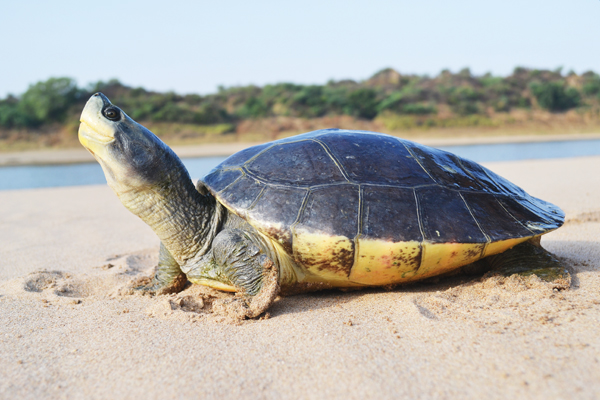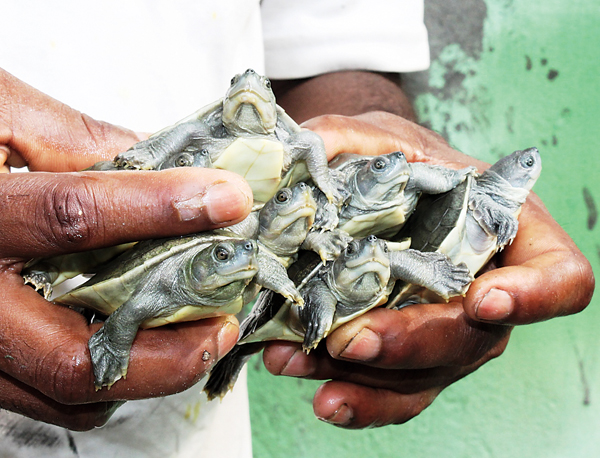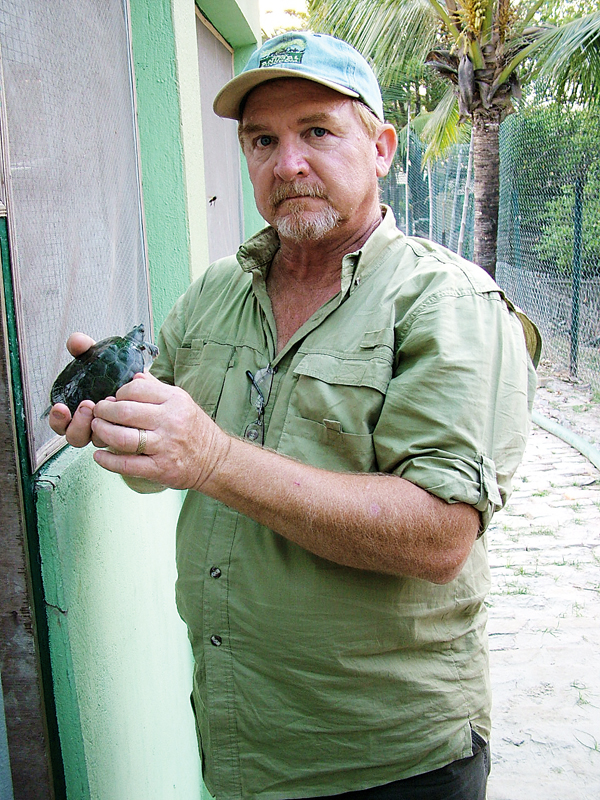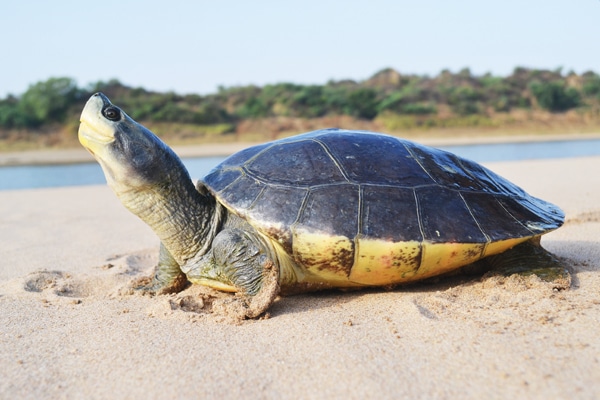The Sundarbans, located between India and Bangladesh, because of a physical environment that includes saltwater crocodiles, numerous insects and a lar
The Sundarbans, located between India and Bangladesh, because of a physical environment that includes saltwater crocodiles, numerous insects and a large tiger population, could actually be the perfect habitat for the Turtle Survival Alliance Northern River Terrapin Recovery Program in India. The Sundarbans is one of the largest mangrove forests in the world, and an area I dreamed of visiting since the first time I read of it in National Geographic!
Areas such as the Sundarbans mangrove forest are wide open for exploitation, simply because most people do not want to venture there. In 1974, the area became a wildlife sanctuary; in 1984, it was deemed a national park, and in 1987, a World Heritage Site. With the added protection from national and international agencies, the Sundarbans was declared a no-fishing zone to protect this vital estuary for the Bay of Bengal. This has halted the majority of large-scale commercial fishing in the area, which was devastating to the northern river terrapin population due to by-catch and the demand for turtle meat from other Asian countries. Also targeted for harvest were the eggs of the turtles, making this cycle of use completely unsustainable.
Currently, mostly subsistent fishermen and honey collectors dare to venture into Sundarbans, and they do so knowing there is a good chance they may be killed by a Bengal tiger (Panthera tigris tigris).
Tigers Among the Mangroves
Life in this region is as problematic for the people as it is for the wildlife, each trying to eke out a living with few resources in a physically demanding environment. The tigers of the Sundarbans are famous for being smaller, yet more aggressive than any other tiger subspecies. Fishermen keep their catches in the same boats where they live while in the mangroves, so it is likely hungry tigers can easily find the boats in the dark merely by following the smell of fish in the thick night air. The taking of fishermen off their small boats in the middle of the night is more common than you might think; in 2014, the year I was there, it was rumored two hundred people were taken in the tiger sanctuary (because people are not permitted in the sanctuary, no accurate records are available).
Honey collectors are taken when they venture onto land to collect honey, often having to travel through waist-deep mud left exposed from the heavy tides. In an effort to help protect them, the government gave away rubber masks to wear on the back of their heads. The theory was that this would confuse a tiger as to which way a person was facing, hence foiling the tiger’s effort to take one that person by surprise. It was a big mistake for several reasons, other than the obvious. First, tigers are much smarter than anticipated. Second, the native people of the region have very dark complexions, and the face color of the masks was more pinkish.
I never saw a tiger during our survey of the area, but there were signs and tracks of them everywhere we ventured on land. Many tracks could be seen, including those of big males and females with cubs, as well as tracks that were following behind deer and hog tracks, evidence of tigers stalking their next meal. Two armed guards accompanied us on all of our excursions, and they never seemed comfortable or relaxed when we were searching beaches for signs of turtle nests or any other evidence that terrapins were present.
Terrapin in Trouble
The northern river terrapin (Batagur baska) is a large turtle with a shell length measuring nearly 2 feet. In 1983, Rom Whitaker reported that fishermen used the fruit of the mangrove tree as bait on hooks to catch the terrapin, establishing a critical piece of evidence verifying an herbivorous diet. As the terrapins mature into adulthood, they lose a marginal spine and vertebral keel seen in juveniles. Adult male heads and throat are colored jet black, the foreleg regions are crimson, and the eyes are golden in color. In contrast, adult females are not nearly as striking, possessing a uniformly grayish head and neck area.

Lonnie Mcaskill
A female Northern River terrapin basking in the sand.
Northern river terrapins are highly sexually dimorphic during the breeding season. In 2000, the International Union of the Conservation of Nature (IUCN) listed B. baska as critically endangered. Once ranging into Myanmar, Vietnam, Singapore and Thailand, it is now found only in Cambodia, Bangladesh, India, Malaysia and Indonesia, in sparse numbers and fragmented populations. It inhabits freshwater, brackish and saltwater, in mangroves and tidal estuaries. Spending most of their lives in the brackish waters of the mangroves and tidal creeks, the females swim out to nest on the sandy beaches of the barrier islands facing the Bay of Bengal. Nesting takes place in this region between February and March, with females depositing an average between 15 to 30 eggs, with an incubation period of 65 to 75 days.
Northern river terrapins will nest on the same beaches used by green sea turtles (Chelonia mydas). While we were looking for Batagur nests on the outer islands of the Sundarbans, we did encounter several old green sea turtle nests where Batagur had been reported nesting, but, unfortunately, no Batagur nests were found. Regardless, there is still viable nesting habitat for the recovery program.
The last recorded nesting of a single female northern river terrapin was in 2008, by one of the forest guards patrolling the area on Mechua Island in the Sundarbans Tiger Reserve. Potentially, there could be juveniles or subadults still inhabiting the area, another piece of evidence indicating this area is vital for restocking.
In 1988, a small hatchery was established for the northern river terrapin at the tiger sanctuary headquarters at Sajanakhali. Eggs collected on Mechua Island were transferred to Sajanakhali to be hatched and hatchings head-started for release. In the late 1990s, however, an administrative change tragically decided to discontinue this program, and most of the B. batagur being held at Sajanakhali were released.
A Program Resurrected
In 2008, Dr. Shailendra Singh discovered eight male and three female northern river terrapins in the retired ponds at Sajanakhali, and he convinced the current administration to restart the program. With the guidance and help of Dr. Singh and the Turtle Survival Alliance (TSA), the program is once again growing as they begin to look at repatriating the northern river terrapin back into the tiger sanctuary. A significant piece of evidence indicating the Sundarbans is a perfect location for a head-starting program for the terrapin occurred in 2013, when several juveniles were captured by fishermen across the Bay of Bengal on the Bangladesh side of the Sundarbans. The notion that there were, in fact, some reproductive animals in the Bay of Bengal in the Sundarbans was very encouraging news!

LONNIE MCASKILL
A group of 1-year-old, head-started Northern river terrapins.
In late March 2014, Dr. Singh, Shashwat Sirsi and I surveyed the outer islands of the Sundarbans Tiger Sanctuary to see if we could find any evidence of nesting females and to investigate possible areas to set up a soft release site prior to repatriating animals back into the sanctuary. Almost simultaneously, across the bay in Bangladesh, Peter Praschag was finding B. batagur in some village and pagoda ponds, and building the nucleus of a breeding group to be created there.
We began our survey at the headquarters of the Sundarbans National Tiger Sanctuary at Sajanakhali. After driving all day from Calcutta, we took a ferry across to the headquarters, where we met the head veterinarian of the park. He introduced himself as the number one vet of the Sundarbans National Park, yet when I asked how many vets were working in the park, he said, “Just me.” I had a bit of a chuckle over that.
There is a museum in the park that educates visitors about the sanctuary and the local people’s way of life. The headquarters has a bit of a prison-camp feel, with its high fences and security watchtowers, but for good reason. It’s in tiger habitat, and we were told it was common to see tigers walking just outside the perimeter fence.
We checked the captive group of northern river terrapins at the park headquarters and looked for nests in the enclosures because it was that time of the year. The B. batagur enclosures are completely netted to protect turtle eggs and hatchlings from water monitors (Varanus salvator), rhesus macaques (Macaca mulatta) and mongoose (Herpestes edwardsii) in the area. The macaques, especially, are a real problem inside the headquarters perimeter fences; they frequently threaten visitors, and I am sure bites are common. They would not hesitate to open the door to a visitor’s room and stand in the doorway, looking for something to steal.
While there, we also got to see a rescued juvenile female tiger that was found close to the ranger station in dire shape. We were told she was at the age of weaning, a time when many tigers do not make the transition from being cared for by the mother to independence. The staff had done an excellent job rehabilitating her, and she would eventually be released within the park’s boundaries.
Surveying the Islands
We overnighted at the headquarters, and the next morning boarded a boat for the 10-hour ride out to the barrier islands, where we would search for signs of nesting turtles over the next six days. We headed south toward the Bay of Bengal on what was at first a large river, but that got narrower and grew smaller until we were navigating through a maze of small waterways through the mangroves. There were no navigational signs and no GPS to show us the way; we relied solely on the boat captain’s memory, gained through years of piloting boats in the area.

Lonnie Mcaskill
Lonnie Mcaskill and a yearling Northern river terrapin.
As we proceeded south, we checked water depths and salinity, and interviewed fishermen to see if they had seen any terrapins recently. Occasionally, we passed a Knat, a shrine where fishermen and honey collectors would leave offerings and pray for a safe return from the mangroves. The sun set, and as the night sky was growing darker the trees along the waterway lit up, as if they were Christmas displays, blinking crazily. They were absolutely covered in lightning bugs! I found the view deceptively beautiful, especially knowing a tiger could be watching our boat as it motored along.
Before we traveled to the barrier islands, we had one more stop to make at the last ranger station in the sanctuary, to do a bit of changing of the guards. Rangers are stationed at this location for a month, then they go home for a week before returning for another month. We arrived well after dark, and the only way we could tell where we were to go, aside from the light of the full moon, was when the light at the end of the dock came into sight.
The view of the station as we pulled up to it reminded me of a World War II prison camp, with spotlights on the fence lines, 12-foot-tall fences, and a dock completely fenced all the way to the end. The rangers from the station joined us for dinner on the boat, then shoved off and anchored us in the middle of the now-fast-flowing reverse tide of the river. I asked a ranger why we didn’t stay tied to the dock, and he just smiled and said, “Tiger.” That was good enough for me!
Update at Press Time
From Dr. Shailendra Singh: “To date, the WBFD/TSA team in India has headstarted 145 B. baska hatchlings at the conservation breeding facility at the forest ranger station within Sunderbans National Park. This year so far, the team has reintroduced 10 juveniles (three males and seven females) from our facility to learn more about their survival and dispersal, as well as habitat use.
The turtles were fitted with acoustic transmitters prior to release, which would allow them to be tracked by biologists. They were placed into a soft-release pen (a contained area of natural habitat that allows the animals to acclimate prior to being fully released to the wild) constructed on a 984-foot-long secondary channel using 800 pieces of bamboo and 50 fishing nets. The turtles were held for about a month, where they were observed and tracked using directional hydrophones and man-track units provided by Sonotronics.
They have been released, but have not yet been tracked due to the vast, rugged terrain that brings with it many logistical challenges—not to mention the risk of tiger attack! However, a two-member research team is continuously monitoring the area near the release site, and there are plans to increase the search radius using small motorboats.
We are yet to locate any animals, and a second round of tracking will begin in early May. If we are not able to locate any terrapins with the current devices, we will use satellite transmitters next year. This result is not totally unexpected, due to the make-up of the Sundarbans’ hundreds of mangrove islands, swift and deep tidal flows, and the turtles’ habit of digging into the mud during low tide. It is, however, a first step, and, hopefully, will receive the attention and support needed to fund the costly satellite tracking that will be able to locate animals in this rugged environment.”
During our survey, we found many areas where pre-release enclosures could be set up to allow head-started northern river terrapins to acclimate before being released into the mangroves. These areas, though, are not without risk to people who would be monitoring the turtles as they were acclimating. When the tide recedes, it leaves many of the small pools drained, and at such times, access is only through thick mud in which saltwater crocodiles (Crocodylus porosus) will burrow unnoticed and lay in ambush. Walking in the mud is difficult, too, as it sucks your legs into it—a potentially perfect scenario for any hungry tiger that may be lurking in the mangroves.
Even though this may not seem like a good place for pre-release pens, we believe the younger Batagur actually prefer such areas. While visiting a head-start facility in Cambodia, Dr. Singh and I noticed that B. baska juveniles would actually burrow into the sand of the land areas of their enclosures. After setting up the head-starting group in India, Dr. Singh noticed that the B. baska there did the same thing, a behavior we had not seen with other Batagur species. I suspect this behavior is in response to the receding tides of the coastal areas that leave them stranded in the tidal pools; they simply burrow down into the mud and wait for the incoming tide to return, a very handy skill to have in this region, as outgoing tides can drop more than 12 feet. Amazing!
Whenever we encountered fishermen, we would interview them and show them photos of the northern river terrapin, both males and females. They all told us that they had seen the turtle, but it had been years ago. When asked if they would keep the terrapins and eat them, the reply was a unanimous, “No.”
One of our nervous staff members would begin the surveys by asking the fishermen if they had seen any tigers, as well as asking how many. We had to convey the importance of maintaining our focus on information specific to the terrapins. However, knowing tigers were common, they were a constant concern to staff and remained on their minds until they returned home.
As we turned the boat north and began our return trip toward Sundarbans National Tiger Sanctuary Headquarters at Sajanakhali, we were all optimistic this project would have a very good chance of success, and that the northern river terrapin would once again be swimming in the mangroves. The habitat was in fine shape and appeared to be healthy. Fishing pressure was relatively low, with only subsistent fishermen being encountered during our stay, even in the most remote areas of the park. The nesting beaches were all in good condition with only minor concern of predation from native pigs. This was obviously a favorite hunting ground of the tigers, as their fresh paw prints were everywhere! The captive animals at park headquarters were breeding, and hatchlings were growing quickly, getting ready for the first phase of the reintroduction process.
As we reached the dock back at headquarters, I think we all relaxed a bit knowing the terrapins would have a good chance at recovery—and also that we were out of Bengal tiger territory!
I would like to acknowledge Mary Anne Locke, Dr. Shailendra Singh and Maksud Rahman for contributions and photos used in this article.
For more information about the Turtle Survival Alliance, please visit turtlesurvival.org; see how you can support freshwater turtle and tortoise conservation.



